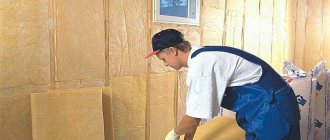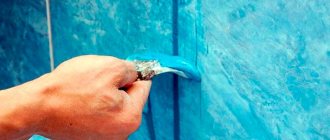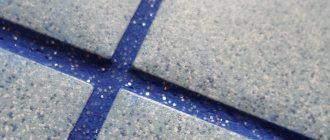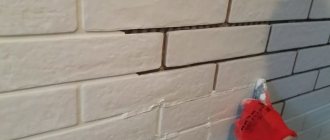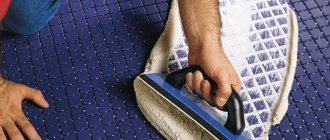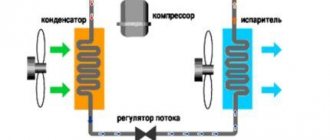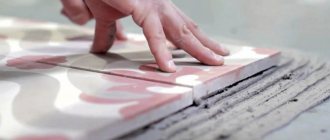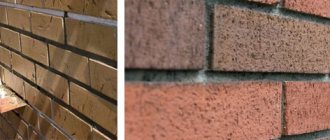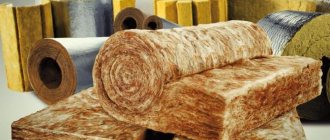The key disadvantage of panel structures is poor-quality sealing of the seams between the slabs.
This contributes to the walls getting wet, the appearance of mold and mildew, and disruption of sound insulation. To eliminate the problem, comprehensive insulation of seams in panel houses is performed.
Insulating seams in panel houses requires a lot of experience.
Reasons for insulating seams in panel houses
For the construction of panel buildings, special building structures are used, which are produced at the factory. At 2 or more junction points, the elements are connected using welding equipment, and the resulting gap is called an interpanel seam.
It needs careful thermal insulation and protection from adverse weather conditions. If the room is not reliably insulated and the joints allow air to pass through, this will lead to constant freezing of the walls, the appearance of dampness and drafts inside the home.
Before opening the seam, you need to make sure that it does not have the required sealing. Drafts often appear due to insufficient sealing of doors and windows.
A questionable seam is carefully checked and a small section is then removed with an ice ax or a mason's hammer. If, after mechanical stress, the material begins to crumble, the seam must be disassembled and re-sealed.
Condensate
The walls begin to accumulate condensation when the dew point moves inside the building. In the absence of effective measures, structures will collapse, and dampness, fungus and mold will appear in the room.
Condensation accumulates as the dew point shifts.
Fungus
If there is insufficient insulation of interpanel seams, fungus appears in the corners of the apartment. In most cases it is black in color.
Mold
Like fungus, mold only accumulates in areas of high humidity. Frequent temperature changes contribute to the progression of this problem.
Mold appears in rooms with high humidity.
Ice formation in winter
The phenomenon is explained by freezing of the seams between the panels. If insulation is not carried out, ice will begin to destroy building structures, reducing their service life.
Humidity
If the slabs are not insulated, traces of moisture may appear in the corners of the room. The problem requires quick and effective action to insulate the seams.
Sealing of glazing seams and ventilated façade panels.
Many panel houses built in the last century are usually insulated and faced with a ventilated facade. Most modern buildings are built with a ventilated facade. Therefore, sealing seams of glazing and ventilated facade panels is work that is quite in demand in modern megacities. Failure to seal the seams of ventilated facades occurs due to violations of construction technology or building maintenance rules. We can not only seal the seams of ventilation facade panels, but also carry out a full examination of the causes of facade defects, as well as carry out high-quality repairs of the ventilated facade.
Regulations
Before sealing seams with insulating material, it is necessary to study the regulations and construction requirements that are specified in them:
- SNiP 02/23/2003 “Thermal protection of structures”.
- SP 23-101-2004 “Design of thermal protection of houses.”
Before sealing seams, study the regulations.
Section 8.11 of the code of practice mentions that it is not recommended to insulate the internal parts of walls due to the likelihood of moisture accumulation in the insulation material. As the dew point shifts into living spaces, the risk of mold, mildew and increased humidity will increase.
When is secondary sealing required?
The timing of secondary sealing cannot be precisely stated, since it is individual for each individual multi-storey building and depends on a number of factors. The following signs may indicate the need for secondary treatment of seams:
- Leaks . This problem causes the greatest damage to the entire panel building. This destructive effect is due to the fact that the moisture that accumulates in the cavity of the joints over time saturates the walls, washing away the constituent components from it and deforming the slabs from the inside during the process of thermal expansion.
- Freezing . It is a direct consequence of leaks, which manifests itself after the onset of cold weather in the off-season, when the heating period has not yet begun.
- Drafts and accelerated heat loss clearly indicate that the material filling the joints between the panels has been destroyed and no longer fulfills its protective and insulating functions.
- High indoor humidity , damp wallpaper, mold and mildew on the walls. The cause of such problems is moisture that penetrates into the house through cracks and voids in the joints.
Material selection criteria: what to look for
To keep the walls dry, you need to choose materials with zero vapor permeability. The following characteristics should also be assessed:
- Thermal conductivity. The lower the level, the better the insulation will be.
- Compliance with environmental standards. This parameter is especially important for residential buildings. If the insulation releases toxic substances during operation, it cannot be used to insulate seams.
- Fire safety. The minimum flammability class of the insulation must comply with the G1 standard.
- Life time. The performance properties of the material must remain identical at different stages of use.
Additional selection criteria include ease of installation and minimal volumes of construction waste after installation.
Professional polyurethane foam
Sealing joints with polyurethane foam without the use of harnesses or sealing tapes is suitable for partial or economical repairs without opening the joints.
This building material allows you to fill all the cracks and holes, and its hardening period lasts from 12 to 24 hours. The remaining parts of the foam can be cut off with any suitable device.
Sealing joints with polyurethane foam is suitable for economical repairs.
Experts do not recommend using insulation without carefully sealing moving seams. During thermal deformations, cracks may appear that allow cold and moisture to pass through.
The advantages of this option include:
- Quick and convenient placement with a nozzle gun.
- Good adhesive properties.
- Uniform distribution at the joint.
- Thermal resistance from -50 to +90 °C.
However, construction foam also has its downsides. Foaming is carried out at a temperature not lower than -10 °C, and the sealing process is accompanied by high costs associated with the cost of a foam cylinder.
Gernite cords
Elastic insulation is made on the basis of foam rubber. Due to its special structure, it is characterized by maximum water and air tightness, allowing you to simultaneously solve the problems of waterproofing and insulation. In addition, the material is characterized by durability and low cost.
Gernite cords are elastic insulation.
One of the disadvantages is the heavy weight - a linear meter of gernite cord with a cross-section of 50 mm weighs 1.5 kg. If the surface layer is damaged, the thermal insulation properties of the material will be greatly reduced.
Polyethylene foam harnesses
Cords based on foamed polyethylene are actively used for heat and waterproofing work when processing seams between the slabs of a panel house.
This elastic insulation is not subject to deformation during compression and retains its shape well throughout the entire period of operation. The list of negative aspects is limited only by the high cost of the harnesses.
Mineral wool
Mineral wool refers to an insulating material that contains extruded stone chips. The internal cavities of the slab consist of 90% air, which has a minimum thermal conductivity coefficient.
Mineral wool contains stone chips.
There are 3 types of mineral wool on sale:
- Basalt. It is in greatest demand due to ease of installation, accessibility and effective thermal insulation. But the material is not used to process the façade of the house.
- Glass wool. It was widely used in the 20th century, but due to the likelihood of crumbling and rapid damage, it lost popularity. When laying glass wool slabs, it is important to use high-quality personal safety equipment.
- Cellulose mineral wool. Complies with environmental standards, but is highly flammable.
Sandwich panels
The material is in demand due to its ease of installation. It is made in the form of a 2-layer plate based on the following components:
- Foamed polyurethane. It is distinguished by high quality in thermal insulation of seams.
- Mineral wool. When combined with a sandwich panel, mineral wool is not subject to the destructive effects of moisture.
- Foam plastic. Cheap insulation is lightweight and affordable.
Styrofoam
The most common insulation on the domestic market, which is not afraid of precipitation or ultraviolet radiation.
The service life is 30-50 years. The foam boards are fixed with dowels or using special glue. The negative point is the release of toxic substances when ignited.
Polystyrene foam is the most common insulation material.
Sealant
Using sealants, you can seal hard-to-reach seams and cracks in building structures. When filling the voids with this material, a dense elastic layer is formed.
Methods for repairing joints
When choosing a method for sealing joints between slabs, you need to take into account the degree of damage to the joint. If you follow the basic rules and instructions, you can complete the repair yourself.
Caulking seams
The method is used for minor damage to the sealing layer and minimal displacement of the panels relative to each other. The insulated surface must be sealed with a sealant that penetrates tightly into all holes and restores the integrity of the coating. In most cases, putty is included in the complex of cosmetic repairs.
Seam putty is used for minor damage.
Waterproofing works
Waterproofing work requires the involvement of specialists, because... accompanied by some difficulties. The joints must be completely cleaned of old sealant, and then applied with a new layer, after drying and degreasing the slabs.
The method does not provide for insulation of seams, so polyurethane-based compounds are used for sealing. They are suitable for use in temperatures ranging from -45 to +75 °C for 10 years.
Combined insulation
The first stage of combined insulation is to remove dirt. Then the polyurethane foam is poured, and at the final stage the seams are treated with mastic.
If the insulation is done efficiently, moisture will not penetrate the seams, and the problem of freezing, dampness and the appearance of fungus will disappear.
Our prices
The exact cost will depend on many factors, including the urgency and scope of work. Continuous sealing
Unit units up to 10001001-5000Over 5000
| Primary sealing using “warm seam” technology (filling voids with polyurethane foam, installing Vilatherm, coating with mastic) | m.p. | from 250 | from 180 | Great Dane |
| Secondary sealing of interpanel seams without opening (removal of the top layers of sealant for maximum adhesion, application of sealant) | m.p. | from 120 | from 90 | Great Dane |
| Secondary sealing with partial opening of the old seam (opening seams in local places, installing vilatherm, coating with mastic) | m.p. | from 280 | from 260 | Great Dane |
| Secondary sealing with 100% opening of the old seam (opening the seam, patching out the contents, filling the voids with polyurethane foam, installing vilatherm, coating with mastic) | m.p. | from 320 | from 280 | Great Dane |
Selective sealing
Unit units up to 10001001-5000Over 5000
| The cost of work is determined individually based on the volume of work, the locality of the placement of “working” joints on the building, and the type of sealing. | m.p. | Great Dane | Great Dane | Great Dane |
Sealing seams using injection method
Unit units up to 10001001-5000Over 5000
| Secondary sealing of interpanel seams without opening using the injection method (removing the top layers of sealant for maximum adhesion, injecting mounting foam along the entire plane of the seam, applying mastic) | m.p. | from 280 | from 260 | Great Dane |
Preparatory activities
At the preparation stage, you should purchase the optimal amount of building materials. It is calculated based on the area of the walls without taking into account windows. The result obtained should be increased by 20%.
In addition to the insulating material, you need to buy a sealant for sealing the seams, as well as a number of consumable components. Among them are dowels, reinforcing mesh, plaster, and glue. For laying mineral wool, iron slats and screws are used.
A drill is included in the required tool kit.
If work will be carried out at height, it is necessary to prepare scaffolding. The tool kit also includes a safety net, a drill and a set of spatulas.
When preparing the walls, you need to get rid of the old coating by removing plaster and cracked paint from the surface. At this stage, it is important to coat the joints with putty and seal with plaster. The insulation is installed only on a flat and clean wall. If it is skewed, it will need to be leveled.
Useful tips
In old apartments, with the constant destruction of insulation, mold begins to develop on the walls. For this reason, mold areas are treated before resealing is performed. This work is performed in the following order:
- the contaminated area is cleaned;
- dried by natural ventilation for three days or using a heat gun;
- treated with biocide;
- covered with finishing materials with antiseptics.
The walls of old buildings, into which fungi have penetrated quite deeply, are very difficult to “cure”. Therefore, it is better to hire a construction team that will process and clean the surface in accordance with technology.
Technologies for processing interpanel seams on the outside
Processing joints between slabs from the outside involves the use of special equipment. In addition, the specialist must have a permit to carry out work at height. Professional climbers from trusted repair organizations have such documents.
Sealing with polyurethane foam
To process the seams with polyurethane foam, you need to prepare special devices. Before sealing, the joint is cleared of old insulation, and the working mixture is distributed through a nozzle. When exposed to air, it will form a dense foam that will completely fill all the cracks. After hardening, the material must be leveled with a mounting knife.
Polyurethane foam is a common material used for insulation.
Polyurethane foam
If the seam has been plastered or has a narrow groove, it is better to use polyurethane foam. A layer of this material must be distributed into holes that are made through 25-35 cm in the plaster. When the foam hardens, its remains can be removed with a knife. Plaster or sealant is reapplied over this layer.
Warm seam
Before carrying out thermal insulation work, the seam is cleaned of dirt or old insulating material. In addition, the surface is thoroughly dried and degreased. The bundles or tubes are placed in the gap and held there by friction. All chips or potholes must be filled with polyurethane foam, and a sealing compound must be applied over the insulation.
This technology is more expensive, but is highly effective.
Is it necessary to open the seam?
There are a number of factors under which the seam must be opened, namely:
- The material from the seam disintegrates when struck with the sharp edge of a climbing hammer;
- The seam is surface plastered and a light layer of sealant is applied to it;
- The wall is very old and the material falls off even with a light touch.
Such seams must be opened, filled and sealed. If the seam is securely concreted or the slabs fit tightly enough to one another, then tearing down the walls is not recommended. It is more advisable to drill neat holes and foam the voids. Some people believe that in order to ensure thermal insulation of the seam, it is necessary to lay vilatherm. This is not so, the fact is that vilatherm itself does not provide heat, it only protects the seam from the penetration of cold by “sealing” the joint. If the seam is foamed correctly and reliably, then heat leakage will not occur.
Nuances of internal thermal insulation
Insulating interpanel seams from the inside is not a comprehensive solution to the problem of dampness and cold in winter, and therefore is only suitable for temporary protection of a structure.
Without high-quality external insulation, the entire thickness of the slab will freeze in the area of the joints, and the dew point will shift to the residential parts of the apartment. To avoid such troubles, you need to fully process the seams on the outside.
Internal insulation is not a solution to dampness.
Thermal insulation of corner vertical joints in external wall panels
Particular attention should be paid to thermal insulation of corner vertical joints
of external walls
, where
heat loss is maximum
. For this purpose, the following measures are applied:
- install insulating liners
(Fig. 4, item 2), - perform an internal bevel of the corner
, - install external insulating pilasters
, - They supply additional heat
at the junction between the panels from a monolithic or freely installed
additional heating riser
.
In buildings with transverse load-bearing walls, insulation of external corners
thickened end external walls,
characteristic of such buildings , or
the installation of an additional internal panel
(Fig. 4).
The implementation of insulation and insulation
of corner joints
in
external wall panels
is shown in Fig. 4
10 mm
and of the same depth
is removed along the edges of the joints In addition, it is RECOMMENDED to arrange a smooth frame
at least
10 mm
.
Execution steps
Regardless of the technology used and the type of insulation, work begins only after preparatory measures have been carried out. All materials are purchased in advance, and subsequent actions are carried out strictly according to the instructions.
Installation of insulation
The glue is spread over the cleaned surface in several layers. If the wall is curved, it can be leveled with an adhesive mixture, but not more than 2 cm.
Then, in the direction from bottom to top, you need to fix the foam plates. After fixing the material, strengthen the fastening with dowels. To do this, holes are made in the slab, an expansion hood is installed and the fasteners are hammered in.
Glue and insulation are distributed over the surface.
Reinforcement
Unlike mineral wool, foam plastic does not require the use of panel materials. However, since it is quite fragile, it needs to be additionally reinforced using iron mesh.
In multi-storey buildings this is done end-to-end. If you overlap the reinforcement, the plaster layer will begin to delaminate.
Padding
The primer composition is distributed before puttingtying the reinforced coating. It is better to apply it in 3 layers, and plastering only after drying.
Plaster
Finishing with a plaster base and painting allows you to disguise the foam under the facade. In this case, people will not be able to notice the joints between panels or insulating sheets, and the appearance of the room will be refreshed.
Plaster allows you to disguise the insulation.
Painting
Waterproof compounds are used to paint plastered surfaces. If there are no financial restrictions, it is better to purchase insulating paint to consolidate the results.
conclusions
Thermal and waterproofing of panel joints in old houses should be carried out in accordance with the “warm seam” technology. This will protect the wall from further destruction, as well as create favorable conditions in the apartment. It is better if the wall is treated over a large area at once, otherwise after a few seasons moisture may destroy part of the repaired surface.
When it is necessary to make temporary repairs, it is permissible to perform cosmetic finishing of the walls or partially insulate the seams. This will help prevent further damage to the walls. It is not recommended to seal cracks from the inside. This is not only wasted money, but also an additional reason for moisture to stagnate in the joints between the panels.
You can figure out how to seal the seams on the outside of a panel house by following the instructions for the “warm seam” technology. However, all work at height is carried out by industrial climbers. This will allow you to do the work better and protect yourself from possible injuries.
Recommended Posts
Heat exchanger for the chimney
Calculation of house ventilation
Natural ventilation in the garage
Layout diagram of a Dutch oven with a stove
Lining the stove in the bathhouse with bricks
How to remove a ventilation pipe through the roof
Frequent mistakes when performing work
There are several mistakes that beginners make when sealing interpanel joints:
- The use of insulating material with an excessively large or insufficient diameter.
- Incomplete removal of remnants of the old layer.
- Using sealant to treat uncleaned surfaces.
- Insulation of seams inside a building without sealing external ones.
The listed deviations occur when solving a problem independently or attracting performers without experience and qualifications.

